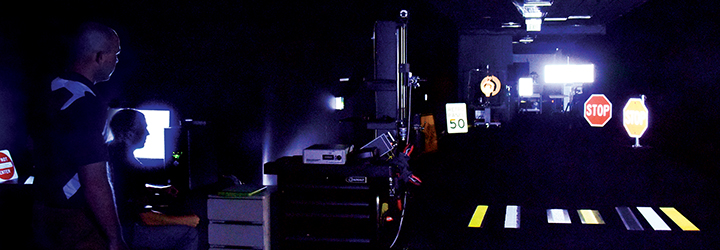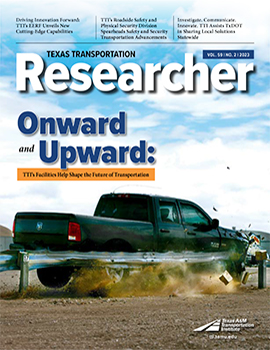Seeing the road and everything around it while driving is not a preferred option; rather, it’s an essential component of safe driving. Driving is a visual activity, and as we make our way down a road, we all look at a wide range of visual inputs — the roadway, the surrounding terrain, other vehicles, roadside buildings, advertisements, and traffic control devices such as signs, markings and signals — to help us get where we’re going. How we distinguish those visual inputs and maneuver the vehicle safely varies from person to person and can depend on quite a number of random, uncontrollable things — the weather, time of day, driver age, health and experience, as well as unexpected distractions inside or outside the vehicle — all can have an effect.
For over two decades, the Texas A&M Transportation Institute (TTI) has developed innovative ways to improve visibility in nighttime driving and has played a major role in standardizing visibility test methods. That dedication to finding solutions has resulted in the development of TTI’s Visibility Research Laboratory, located on the first floor of TTI’s State Headquarters Building on the Texas A&M-RELLIS campus.

TTI’s Visibility Research Laboratory is the first of its kind in a university setting. The lab features a 140-foot-long by 15-foot-wide corridor for testing retroreflective materials as well as coatings, lights and other technologies designed to provide nighttime visibility. The lab also has ventilation systems to allow full-size vehicles to run in the lab while conducting human factors testing and evaluating installed headlamp illumination.
The room was built for future installation of rainmaking equipment to allow assessment of visibility of devices under wet conditions. The 140-foot tunnel-shaped facility also allows researchers to run human-subject night simulation studies under controlled conditions at any time during the day. An adjacent conference room provides space for presentations, where sponsors and visitors can examine samples of reflective materials with microscopes.
“For the last 50 years, TTI researchers have conducted full-scale, closed-course nighttime driving studies at the RELLIS campus,” says TTI Associate Research Engineer Adam Pike. “This outdoor facility allows for static and dynamic visibility and human factors research at speeds of up to 70 miles per hour. The Visibility Research Laboratory complements this full-scale testing facility and allows us to take our visibility research to the next level.”
